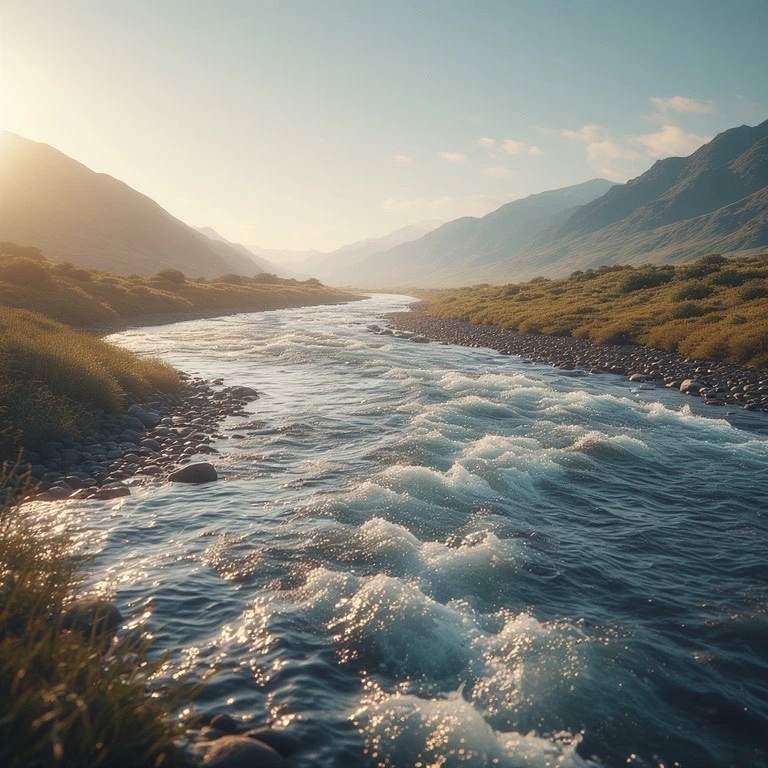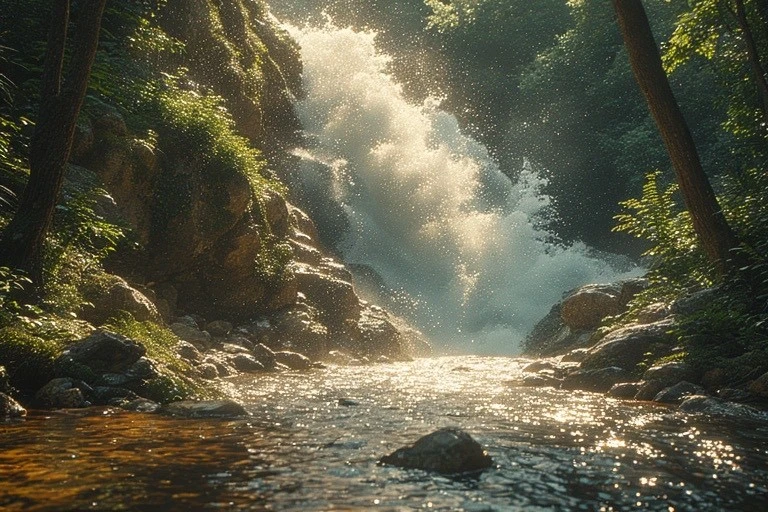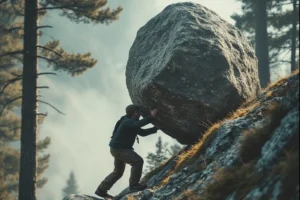Flow vs. Resistance is a simple concept to understand, but it can be tricky to implement. Get it right and it will change your approach to everything and usher in success.
The Two Forces that Shape Your Life – Flow vs. Resistance
Any decision, any action, anything you can possibly dream of operates from two ‘forces’ – flow and resistance.
Everyone spends their life creating resistances and wondering why progress seems so hard.
Learning to recognise these forces helps you to vastly improve your life by taking action that always leads to better outcomes. Pretty bold claims, but the proof is in the pudding, so give it a try, perhaps starting small and then working up toward a complete shift in your perspective.
Ultimately, the results will speak much louder than words.
What is Flow?

Flow is the route of optimal efficiency. Or commonly in wisdom texts described to some extent as the path of least resistance.
It goes beyond just ‘least resistance’ though, because it is actually a state where you make progress toward goals in the best way possible.
To build an image in your head, flow is very much like water running downhill. It works with the environment around it to flow freely, sometimes encountering rocks (resistances) but navigating around or over them with ease.
Water, in this example, gets to its desired destination with the least amount of effort, will take surprising paths to avoid landscapes that prevent its flow, and when all is said and done and it reaches the end of its journey – hindsight will show it took the best possible route.
What Does Flow Feel Like?

In our lives, flow or being in a flow state is noticeable, and I am sure at points in our lives we have all felt these conditions to some extent.
- Solutions to problems appear when you stop fretting or trying to force outcomes.
- Effortless conversations and teamwork.
- Opportunities arrive at the right moment.
- Your personal energy level sustains itself through situations that others would see as challenging and tiring.
- Actions feel natural and unforced.
Examples You May Have Encountered in a Flow State
Human experience varies greatly, and not all examples of flow will be applicable to everyone. However, common examples where people feel things flowing naturally are:
- Job interviews where everything clicks and the job and applicant mesh perfectly.
- A relationship that develops naturally without manipulation or game playing.
- Doing something creative that seems to take on a life of its own.
- Making investment decisions that seem obviously right.
- A difficult conversation that resolves itself at the right moment.
What is Resistance?

In short, a resistance is anything that blocks the natural order of a situation.
While flow is fairly easy to understand but difficult to achieve, resistance is the opposite. It can be very difficult to establish what is causing resistance and, unfortunately, resistances are very easy to establish in your life.
Resistance in a grand sense is like trying to push water uphill or force a key into a lock that doesn’t fit. Resistances on small scales can be finding solutions to problems that cause more problems down the road – such as telling a lie.
What Does Resistance Feel Like?
Resistance comes in so many different forms that there is no one size fits all ‘how it feels.’ However, commonly you will feel:
- Like you are constantly moving from one problem to another.
- Like you’re having conversations that you think need to be had but create more tension.
- That opportunities seemingly slip away despite deeply wanting them and making tremendous effort.
- Tiredness and lack of motivation or energy.
- Like taking action is a constant struggle.
Examples You May Have Encountered that Are Resistance
Resistances are more common than flow, because humans seem to operate from a point of high resistance in general. All of the examples should resonate with your lived experience, either directly or through actions of others you have observed.
- Trying to convince someone who isn’t ready to listen.
- Forcing a business idea that the market doesn’t want.
- Staying in a situation that consistently makes you feel ‘down’ or demoralised.
- Making decisions based on what you think you ‘should’ do rather than taking a decision that feels right.
- Chasing outcomes and trying to reach them with your own strategy rather than creating the conditions in your life where the outcomes naturally emerge.
The Navigation Principle

Here’s the important aspect of this framework. You ALWAYS have the choice between flow and resistance across all levels of your life.
Every situation you encounter has multiple approaches you can take. Most choices will be resistance creating options. As you get better at identifying flow and resistance patterns in your life, you will be able to see the flow approach and avoid the resistance creating options.
Learning to identify resistance and flow patterns transforms your ability to navigate through life.
The Simple Test – Flow vs. Resistance
When facing your next decision or challenge, ask yourself:
“Does this approach feel like pushing water uphill or letting it find its natural path?”
If the approach has a clear uphill feeling, you are likely going to encounter a strong resistance.
Even a slight uphill feeling points to subtle initial resistance and once you venture down that road, unfortunately resistances tend to accumulate.
If the approach feels like a natural pathway – this indicates more of a flow state than a resistance creating state, and you should trust the process.
At first you may find it really difficult to find those natural pathways, and sometimes taking a natural approach is simply doing nothing at all – which can cause people discomfort especially if they feel they should be doing something, even if that something is not optimal.
Trust is critical here. Trust natural intuition and let the results speak for themselves.

Common Flow vs. Resistance Patterns
In Personal Relationships
A flow state in personal relationships looks like:
- Communicating with ease when the other person is naturally receptive.
- Expressing your authentic thoughts and feelings without trying to control the other person’s response.
- Enabling space for understanding and resolution rather than demanding someone agrees with you.
Resistance in a personal relationship feels very different and often leads to the worst possible outcomes.
- Forcing ‘tough’ conversations when the other person is not ready, stressed, or closed off.
- Trying to convince someone to change their mind.
- Manipulating or applying pressure to try and get the outcome you want.
In Our Careers

Flow in our work or careers looks like:
- Building skills that come naturally and excite you.
- Opportunities arising that match those skills you have built.
- Networking that aims to help others rather than asking for favours.
Resistance in our careers feels very different:
- Taking the job because you need the money even though you hate it.
- Chasing opportunities when there is no mutual benefit to others.
- Networking by asking others to help you or give you time, favours or money.
In Problem Solving – Flow vs. Resistance

Flow in problem solving is incredibly effective, and normally a problem has arisen due to resistance, so being able to flow elegantly out of it feels amazing.
- Stepping back and allowing solutions to naturally emerge when you feel stuck.
- Assessing problems from different angles rather than rushing to action at the first ‘workable’ solution you can think of.
- Using your own natural authentic problem-solving style rather than copying others.
Resistance in problem solving is like compound interest on a loan. The resistances add to the existing problem and before long you are emotionally drained and reaching breaking point.
- Resorting to the same failed approach for new problems and expecting different outcomes.
- Using solutions that create new problems to add to the existing problem.
- Working against your authentic self and natural thought patterns.
The Counterintuitive Truth – Flow vs. Resistance
As mentioned, achieving a flow state can be difficult, especially at first. Identifying the myriad forms of resistance we have in our daily lives is daunting to say the least. To outsiders, operating from flow can look like ‘giving up’ when in reality you are taking an approach that optimises your circumstances to get the best outcome.
Remember, those judging your approach will have their own lives filled with resistance patterns.
Flow from the outside looks like:
- Taking a break when stuck that seems like you have quit.
- Waiting for natural flow to emerge can look like procrastination.
- Changing your approach from old, failed approaches can look like inconsistency or self-doubt.
- Letting go of forcing outcomes can seem like a lack of ambition.
Ultimately, you will understand from your perspective that none of these criticisms apply. Soon your results will speak volumes about your approach and people who understand natural flow consistently achieve the best outcomes with much less stress.
How To Develop Flow in Your Life
For some personalities, flow states are easier to achieve than others, and we all know that one person who seemingly lands on their feet despite the problems they face. Even those who naturally have better inclination to operating in flow also have an abundance of resistances, and can improve their understanding and develop their skills.
If you feel your personality is not particularly designed for flow, you can start off with basic steps and build. It is a skill that can be developed by anyone. Remember, thinking you can’t build the flow skill is actually a resistance pattern.
Here are some practical steps you can take.
Step One – Pay Attention to Energy Levels

If you’re noticing high and sustainable energy it usually means you are either in a flow state or approaching a flow state. If you feel depleted or you’re forcing your focus in directions this is usually resistance.
Step Two – Notice Timing – Flow vs. Resistance
When you’re in flow, the timing of your decisions and actions feels obvious and natural. When operating through resistance the timing will always feel off and require constant corrections and ‘pushing through.’
Step Three – Watch for Compound Effects
A flow solution will often resolve multiple problems at once. As discussed earlier, resistance approaches often create more problems and poorly fix the initial problem (if at all).
Step Four – Trust the Process – Flow vs. Resistance
Once you begin to recognise your flow, patterns will emerge that make using flow approaches easier in the future. Your intuition gets better at spotting resistance approaches, and it becomes a honed skill.
Trust builds over time; seeing the flow approach pay off in the first instance will help you develop trust in the process. However, you will need to always be able to fall back on a basic level of trust, because being in a flow state doesn’t preclude the problem getting worse before it is resolved fully.
What is a Flow Mindset?
Being in flow is not about being passive. This isn’t a sit back and hope for the best approach. Adopting flow in your life is an active participation in awareness and skilful choice making.
If it was as easy as ‘going with the flow’ we would all be doing it. In fact, a flow mindset is oftentimes finding the flow state in complex situations. It really is a skill to actively develop.
The best way I can think of explaining this mindset is as a skilled navigator on a ship.
- You can read the maps and chart the best courses.
- You can adjust course without issue if unforeseen obstacles arise.
- You are using natural forces (the wind in your sails) to your advantage rather than battling against them.
- You always get to where you want to go in the optimal way – rather than in the dramatic way.
How To Start With Flow Today

Pick an area in your life where things feel difficult right now. It can be something small or big. However you personally feel comfortable testing the approach.
When you have crystalised the issue in your head, ask a simple question:
“What would a flow approach look like in this situation?”
At this point, your mind might run through any number of scenarios that seem like solutions or what you expect to be a flow approach. The key here is to let your mind settle and let the solution emerge rather than forcing it or grasping at the first answer that springs to mind.
A little trick is that the flow path often naturally emerges after you stop trying to make resistance paths work.
Flow in some situations may not avoid ALL difficulty, in fact most flow approaches require some difficulty, but a flow approach will energise you rather than deplete you. Similar to water forging a new path through terrain to navigate around an obstructive rock.
Flow doesn’t mean easy (although with practice and development, challenges do become easier to navigate), it means the best, most efficient path to success.
Bookmark this Navigational Guide

You can use this guide as a navigational compass, returning to it whenever a new challenge or problem arises, reorienting yourself to flow principles when life feels unnecessarily hard.
Some problems in life happen outside of our field of control, we know this intuitively. How we respond to those problems really sets us apart in terms of successful outcomes.
Most problems are also not as difficult as we think they are – mainly this perception of difficulty comes from a history of approaching situations from the wrong angle. Once you have mastered flow vs. resistance principles you will be staggered by the improvement you see in all areas of your life.





